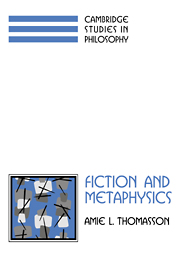Book contents
- Frontmatter
- Contents
- Acknowledgments
- Introduction: From Fiction Into Metaphysics
- Part One The Artifactual Theory of Fiction
- Foreword
- 1 If we postulated fictional objects, what would they be?
- 2 The nature and varieties of existential dependence
- 3 Fictional characters as abstract artifacts
- 4 Reference to fictional characters
- 5 Identity conditions for fictional characters
- Part Two Ontological decisions
- Notes
- Bibliography
- Index
5 - Identity conditions for fictional characters
Published online by Cambridge University Press: 23 September 2009
- Frontmatter
- Contents
- Acknowledgments
- Introduction: From Fiction Into Metaphysics
- Part One The Artifactual Theory of Fiction
- Foreword
- 1 If we postulated fictional objects, what would they be?
- 2 The nature and varieties of existential dependence
- 3 Fictional characters as abstract artifacts
- 4 Reference to fictional characters
- 5 Identity conditions for fictional characters
- Part Two Ontological decisions
- Notes
- Bibliography
- Index
Summary
One fear that inclines many to reject fictional objects is that we are liable to get ourselves into trouble either by falling into contradiction or by trying to constrain such unruly entities into the confines of a well-behaved theory. The motivation for rejecting fictional objects on the basis of their supposed intractability goes back at least as far as Russell's claim that Meinong's nonexistent objects are “apt to infringe the law of contradiction” and has gained contemporary popularity from Quine's characterization of unactualized possible objects (and presumably other so-called nonexistents) as “a breeding ground for disorderly elements,” making them unsuitable for proper individuation and untractable in philosophical theories.
Those who do attempt to offer identity conditions for fictional objects generally do so by reducing fictional objects to ideal abstracta, so that their identity conditions are reduced to those of more familiar and tractable entities. But such attempts inevitably miss important aspects of our ordinary practices in counting characters as the same or different. This difficulty is not unique to fiction: Indeed, some of the stickiest problems of identity arise for other cultural artifacts such as statues and monuments, musical works, and literary works, which are not identifiable with either basic physical concreta or with ideal abstracta and which thus seem to demand identity conditions different from those for either.
By conceiving of fictional objects as abstract artifacts we can offer identity criteria for fictional objects both within and across literary works that not only are as clear and precise as those we have for ordinary objects but also correspond closely to our practices in treating fictional characters as the same or different.
- Type
- Chapter
- Information
- Fiction and Metaphysics , pp. 55 - 70Publisher: Cambridge University PressPrint publication year: 1998



